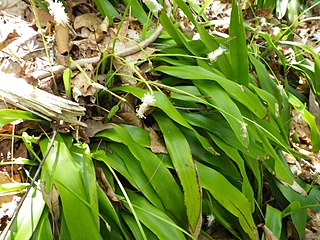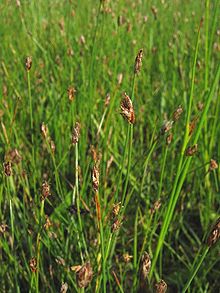
The Cyperaceae are a family of graminoid (grass-like), monocotyledonous flowering plants known as sedges. The family is large, with some 5,500 known species described in about 90 genera, the largest being the "true sedges" genus Carex with over 2,000 species.

Rhynchospora is a genus of about 400 species of sedges with a cosmopolitan distribution. The genus includes both annual and perennial species, mostly with erect 3-sided stems and 3-ranked leaves. The achenes bear a beak-like tubercule and are sometimes subtended by bristles. Many of the species are similar in vegetative appearance, and mature fruits are needed to make a positive identification.

Eleocharis is a virtually cosmopolitan genus of 250 or more species of flowering plants in the sedge family, Cyperaceae. The name is derived from the Greek words ἕλειος (heleios), meaning "marsh dweller," and χάρις (charis), meaning "grace." Members of the genus are known commonly as spikerushes or spikesedges. The genus has a geographically cosmopolitan distribution, with centers of diversity in the Amazon Rainforest and adjacent eastern slopes of the South American Andes, northern Australia, eastern North America, California, Southern Africa, and subtropical Asia. The vast majority of Eleocharis species grow in aquatic or mesic habitats from sea level to higher than 5,000 meters in elevation.

Fimbristylis is a genus of sedges. A plant in this genus may be known commonly as a fimbry or fimbristyle. There are 200 to 300 species distributed worldwide. Several continents have native species but many species have been introduced to regions where they are not native. Some are considered weeds. These are typical sedges in appearance, with stiff, ridged stems and cone-shaped terminal panicles of spikelets. They are found in wet environments, and are most diverse in tropical and subtropical regions.

Cyperus fuscus is a species of sedge known by the common name brown galingale, or brown flatsedge. This plant is native to much of Europe, Asia and North Africa from England, Portugal and Morocco east to China and Thailand. It is an introduced species in North America, where it is naturalized in widely scattered locations in the United States and Canada.
Cyperus niger is a species of sedge known by the common name black flatsedge. This plant is native to the Americas, where it can be found in wet areas from South and Central America to the southwestern United States, from California and Oklahoma south to Argentina.

Dulichium is a monotypic genus of sedge containing the single species Dulichium arundinaceum, which is known by the common name threeway sedge. This is an aquatic or semi-aquatic plant of the lakes, streams, and ponds of the United States and Canada It has a wide distribution across the two countries, though noticeably absent from the Dakotas and from the Southwestern Deserts.
Eleocharis atropurpurea is a species of spikesedge known by the common name purple spikerush. This is an aquatic plant native to much of. It also has a wide distribution in temperate regions of North and South America and Asia. It is present in Europe, where it may be an introduced species for the most part.

Eleocharis palustris, the common spike-rush, creeping spike-rush or marsh spike-rush, is a species of mat-forming perennial flowering plants in the sedge family Cyperaceae. It grows in wetlands in Europe, North Africa, northern and central Asia and North America. Eleocharis palustris is not easily distinguished from other closely related species and is extremely variable worldwide itself. The species epithet palustris is Latin for "of the marsh" and indicates its common habitat.

Kyllinga is genus of flowering plants in the sedge family known commonly as spikesedges. They are native to tropical and warm temperate areas of the world, especially tropical Africa. These sedges vary in morphology, growing to heights from 2.5 centimeters to a meter and sometimes lacking rhizomes. They are closely related to Cyperus species and sometimes treated as part of a more broadly circumscribed Cyperus.

Cyperus laevigatus is a species of sedge known by the common name smooth flatsedge.
Eleocharis montevidensis is a species of spikesedge known by the common name sand spikerush. It is a widespread coastal plant native to the Americas. It grows in moist, sandy spots in many habitat types, including lakes, riverbanks, wet meadows, and springs. It has a disjunct distribution, in North America and South America.

Eleocharis parvula is a species of spikesedge known by the common names dwarf spikerush, small spikerush and hairgrass in aquaria. It is a plant of brackish and saltwater habitat, such as marshes and mudflats. It is a perennial herb growing tufts of spongy, compressible stems not more than 10 centimeters tall. The plant grows from a tuber which is J-shaped or horseshoe-shaped, a characteristic that helps in the identification of the species. The inflorescence is an oval-shaped spikelet just 2 or 3 millimeters long, made up of several tiny flowers.

Galium murale is a species of flowering plant in the coffee family known by the common names small goosegrass, yellow wall bedstraw and tiny bedstraw. It is native to the Mediterranean Basin of southern Europe and northern Africa, and the Middle East from Turkey and the Caucasus east to Iran and south to Saudi Arabia and Somalia. It is also considered native to the Canary Islands, Madeira and the Azores. It is naturalised in Australia, New Zealand, Argentina, Chile and California.

Schoenoplectus pungens is a species of flowering plant in the sedge family known as common threesquare, common three-square bulrush and sharp club-rush. It is a herbaceous emergent plant that is widespread across much of North and South America as well as Europe, New Zealand and Australia.

Schoenoplectus heterochaetus is a species of flowering plant in the sedge family known by the common name slender bulrush. It is native to North America, where it can be found in scattered locations in Canada and the United States.

Schoenoplectus subterminalis is a species of flowering plant in the sedge family known by the common names water bulrush, water club-rush, and swaying bulrush. It is native to North America, where it is known from many parts of the Canada and the United States. It has been common in the northeastern US and eastern Canada as well as the Great Lakes region, as well as many locations in the mountains of the West, though apparently absent from the Southwest and from most of the Great Plains.

Vaccinium oxycoccos is a species of flowering plant in the heath family. It is known as small cranberry, marshberry, bog cranberry, swamp cranberry, or, particularly in Britain, just cranberry. It is widespread throughout the cool temperate northern hemisphere, including northern Europe, northern Asia and northern North America.

Carex fraseriana is a perennial member of the sedge family with the common name Fraser's sedge. It was the only species of the genus Cymophyllus before it was re-transferred to Carex.

Trichophorum cespitosum, commonly known as deergrass or tufted bulrush, is a species of flowering plant in the sedge family. It was originally described by the Swedish naturalist Carl Linnaeus in 1753 as Scirpus cespitosus, but was transferred to the genus Trichophorum by the Swedish botanist Carl Johan Hartman in 1849, becoming Trichophorum cespitosum.

















